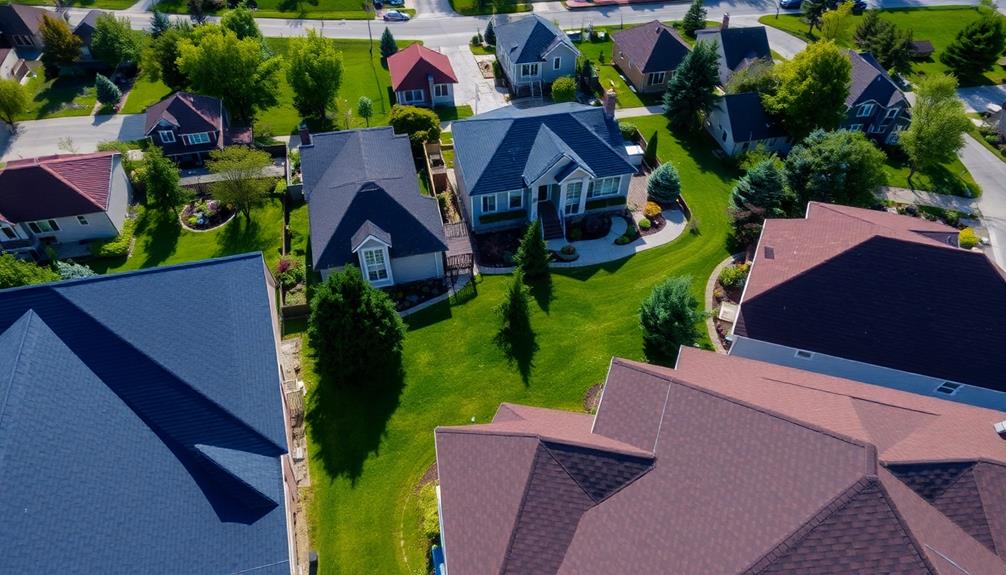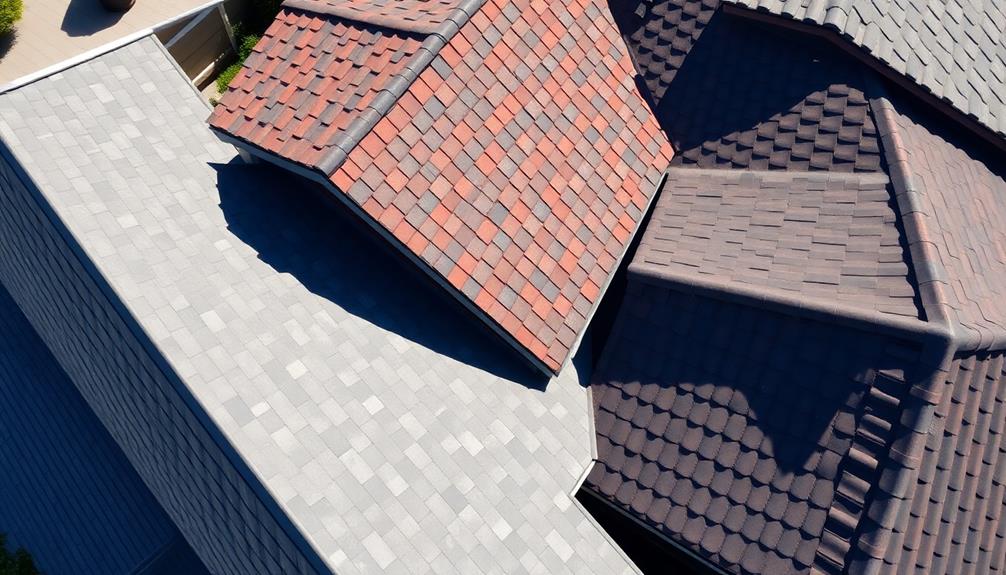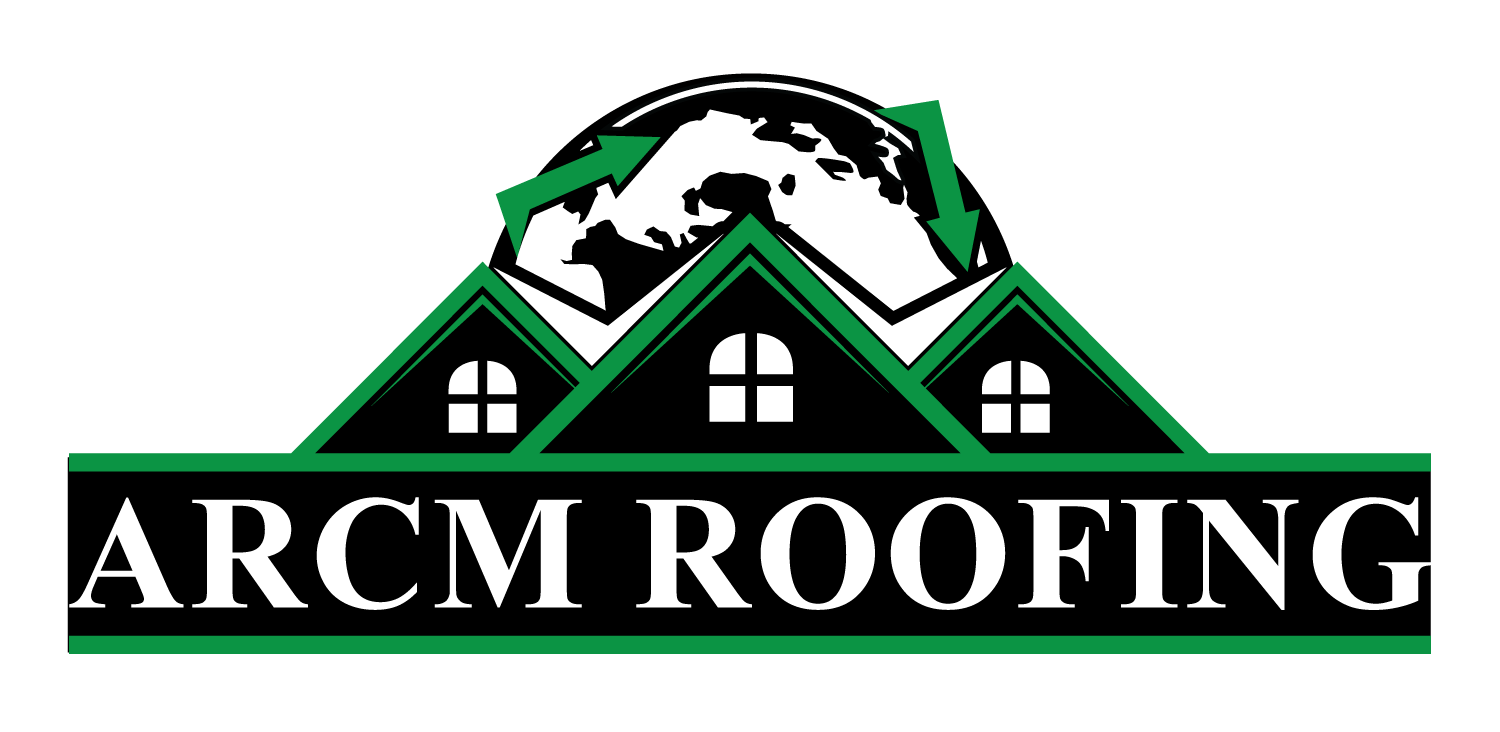Residential roof types present a variety of designs distinguished by their aesthetic appeal, durability, and energy efficiency. The classic gable design, with its triangular silhouette, offers simplicity and effective water runoff, while the hip structure enhances stability and insulation. Modern flat roofs combine minimalist elegance with the ability to integrate sustainable technologies like solar panels and green rooftops. Roofing materials range from cost-effective asphalt shingles to highly durable metal, tile, and slate options, each with unique lifespan considerations and maintenance needs. Understanding these elements can guide you towards choosing the most suitable roofing solution for your home.
Roofing Highlights
- Classic gable roofs feature a triangular shape, offering simplicity and effective water runoff.
- Hip roofs provide durability, stability, and enhanced thermal performance with sloping sides converging at the ridge.
- Modern flat roofs are minimalist, supporting rooftop gardens, solar panels, and maximizing interior space with skylights.
- Choosing roofing material impacts cost-effectiveness, durability, and aesthetics, including options like asphalt, metal, and tile.
- Energy efficiency is bolstered by reflective materials, reducing utility costs and greenhouse gas emissions.
Popular Roof Shapes

In considering popular roof shapes for residential architecture, the classic gable design continues to be a favored choice due to its straightforward construction and efficient water runoff capabilities.
Equally remarkable is the versatile hip structure, which offers enhanced stability and wind resistance through its inward-sloping sides, catering to regions with harsher weather conditions. Additionally, these structures are often fitted by highly-skilled and professional teams, ensuring quality and customer satisfaction.
The modern flat aesthetic, favored in contemporary designs, provides a sleek, clean appearance combined with the practicality of accommodating rooftop equipment and creating additional outdoor living spaces.
Classic Gable Design
A timeless elegance characterizes the classic gable design, making it a staple in residential architecture across the globe. This design is distinguished by its simplicity and practicality, often featuring two sloping sides that meet at a central ridge, forming a triangular silhouette. This shape not only grants the structure an aesthetically pleasing appearance but also serves a functional role, directing rainwater and snow away from the roof, consequently reducing the risk of water damage. Its enduring appeal lies in its adaptability to various styles and materials, from rustic wooden shingles to modern metal sheets, ensuring harmony with diverse architectural preferences.
The gable roof’s straightforward design enhances ease of construction and maintenance, making it an accessible choice for both new builds and renovations. Additionally, the steep pitch of a classic gable efficiently accommodates additional insulation, providing homeowners with improved energy efficiency and comfort. For communities seeking a connection through architectural continuity, the prevalence of classic gable roofs fosters a sense of timelessness and familiarity, reinforcing neighborhood identity. Whether incorporated into a traditional home or a contemporary design, the classic gable roof continues to offer both functional excellence and a reassuring sense of belonging to its occupants.
Versatile Hip Structure
When seeking a harmonious blend of functionality and aesthetic versatility, the hip roof stands out as an exceptional choice in residential architecture. Characterized by its sloping sides that converge at the ridge, seamlessly integrating into the walls, the hip roof endows a structure with durability and visual appeal. This roofing design mitigates wind uplift due to its inclined surfaces, offering a stable silhouette that withstands harsh weather conditions, rendering it ideal for homeowners in regions prone to storms or hurricanes.
Beyond its strength, the hip roof provides a sense of unity and balance. It enhances the structure’s acoustic and thermal performance by naturally directing rainwater runoff and promoting adequate ventilation through its unified slopes. Additionally, it provides ample opportunities for insulation, subsequently improving energy efficiency within the residence—a valuable trait for those seeking sustainable living.
Recognized for its adaptability, the hip roof lends itself to a myriad of architectural styles, blending seamlessly with both contemporary and traditional designs. This versatility fosters a sense of belonging for homeowners as it complements varied exterior palettes, creating a cohesive community aesthetic. With its distinguished features, the hip roof emerges as a prudent choice, promising both longevity and a harmonious appearance.
Modern Flat Aesthetic
Building upon the innovative strides in contemporary architecture, the modern flat roof epitomizes minimalist elegance and practicality. This roof style, increasingly favored in urban developments and eco-conscious communities, often combines clean lines with the opportunity for advanced insulation and energy-efficient materials. By leveraging its simplicity, a flat roof design enables seamless integration with rooftop gardens, solar panels, and green roofing technologies, fostering an ethos of environmental responsibility and sustainability.
Modern flat roofs also excel in maximizing interior space and adaptability, supporting open-concept living that aligns with the forward-thinking homeowner’s aspirations. The absence of traditional pitches facilitates higher ceilings and panoramic skylights, enhancing natural light flow and fostering a sense of spaciousness that many seek. Additionally, the flat roof’s clean aesthetic allows for functional customization, permitting architectural diversities like rooftop terraces or additional living spaces.
Urban landscapes favor these designs for their capacity to blend into complex skylines while accommodating infrastructural needs. Constructed with robust materials such as EPDM, PVC, and built-up roofing systems, these structures promise durability and require minimal maintenance. In sum, the modern flat roof inspires a harmonious blend of form and function, defining contemporary living spaces with timeless sophistication.
Benefits

When selecting the ideal residential roof type, homeowners can benefit from several key advantages such as energy efficiency, which often results in long-term utility savings, and enhanced durability features that safeguard the structure’s resilience to various environmental factors. Opting for impact-resistant materials, which comprise 83% of the installations by ARCM Roofing, further enhances the durability of residential roofs.
Additionally, the aesthetic appeal of modern roofing designs boosts curb appeal, potentially increasing property value, while cost-effectiveness considerations allow for mindful budgeting without sacrificing quality. These attributes combine to offer a roofing solution that is both practical and visually pleasing, meeting diverse homeowner needs.
Energy Efficiency Advantages
A well-designed residential roof can greatly enhance a home’s energy efficiency, offering several benefits that extend beyond mere cost savings. A primary advantage of energy-efficient roofing is its ability to regulate indoor temperatures, thereby reducing the reliance on heating and cooling systems.
Reflective roofing materials, such as metal or specialized shingles, adeptly deflect sunlight, minimizing heat absorption and keeping interiors cooler during summer. Similarly, during colder months, well-insulated roofing systems work to retain warmth, maintaining a comfortable ambiance without excessive energy use.
Further, leveraging advanced technology in the form of cool roofs not only diminishes energy consumption but also markedly enhances overall living quality. By reducing the demand for artificial climate control, homeowners contribute to diminished greenhouse gas emissions, promoting environmental sustainability and forging a collective step toward energy-conscious living. This sense of contributing positively to a larger eco-friendly community resonates with many.
Moreover, energy-efficient roofs often qualify homeowners for various financial incentives, including tax rebates and energy credits, facilitating a reduction in upfront costs of roof installation. Consequently, investing in energy-efficient roof solutions seamlessly combines ecological responsibility with practical financial advantages, fostering a united effort toward a sustainable future.
Enhanced Durability Features
Homeowners looking to enhance the longevity of their roofs will find that selecting materials with superior durability features offers significant benefits. Investing in robust roofing solutions not only extends the lifespan of the roof but also provides added protection against inclement weather conditions, including heavy rainfall, strong winds, and harsh sunlight. When communities band together in making informed decisions regarding their building materials, everyone gains from shared wisdom and mutual support, thereby fostering a sense of belonging and security.
Advanced roofing technologies are now integrating materials such as impact-resistant shingles and corrosion-resistant metal. Such innovations offer resilience against environmental stressors, thereby reducing the need for frequent repairs or replacements. Highly durable roofing systems not only contribute to the overall structural integrity of the home but also help in maintaining its value over time, further enhancing the appeal of the property as a stable investment.
In addition, these durable materials often incorporate cutting-edge technology for easy maintenance and energy efficiency. Homeowners in areas prone to weather extremes can particularly benefit, ensuring their homes remain a safe haven. Emphasizing durability translates to lower long-term costs, an appealing advantage for those seeking to build and sustain lasting communities.
Aesthetic Appeal Benefits
The aesthetic appeal of a roof greatly contributes to the overall visual harmony and curb appeal of a home. A roof’s design, color, and material choices reflect the homeowner’s style and complement the architectural elements of the residence. For those who take pride in their home’s appearance, aligning the roof style with the surrounding ambiance is paramount.
Aesthetically pleasing roof types, such as slate or tile, present timeless elegance, while modern metal or green roofs convey contemporary sophistication. These choices invite admiration, creating a sense of community belonging through shared neighborhood standards.
Roof aesthetics are not solely about appearance; they also involve emotional resonance and identity. A thoughtfully designed roof can evoke a sense of warmth and stability for both residents and observers alike. By harmonizing with the landscape and local environment, the roof’s aesthetic presence can foster community appreciation and cohesion.
Additionally, selecting roofs with functional beauty, such as those that incorporate skylights or dormers, enhances interior light and space, thereby increasing the quality of life within. Consequently, the aesthetic appeal inherently underpins the roof’s role as both an architectural feature and a beacon of neighborhood unity, elevating the homeowner’s sense of pride and belonging.
Cost-Effectiveness Considerations
When evaluating residential roof types, understanding cost-effectiveness is pivotal for making informed decisions. The cost-effectiveness of a roofing material is not solely determined by its initial price but rather by a combination of factors including lifespan, maintenance requirements, and energy efficiency. Homeowners seeking a roof that blends seamlessly into their community while providing long-term savings can benefit from an encompassing evaluation of these factors.
For instance, asphalt shingles, which are among the most common choices, offer an attractive initial cost but may require more frequent replacements compared to metal or tile roofs, thereby impacting long-term economic prudence. Conversely, metal roofs, though initially more expensive, can offer substantial savings due to extended lifespans and minimal maintenance demands.
The energy efficiency of each material is also essential; reflective coatings on certain roofs can notably reduce cooling costs, contributing to accumulated savings. Furthermore, homeowners must consider local climate and environmental factors since these can influence the overall durability and maintenance needs of different roofing types, thereby affecting cost-effectiveness. Understanding these elements ensures that families and communities make decisions that foster both financial security and environmental harmony over time.
Material Options Summary

In evaluating residential roof types, homeowners are often faced with a diverse array of materials, each offering unique benefits with respect to longevity, durability, and a delicate balance between cost and performance. Below is a concise comparison chart that highlights popular roofing materials, providing clarity on how they measure up across these critical aspects. This summary serves as an instrumental guide to assist in making informed decisions tailored to specific needs and priorities.
| Material | Key Considerations |
|---|---|
| Asphalt Shingles | Moderate durability, cost-effective |
| Metal Roofing | High durability, more expensive |
| Tile Roofing | Long lifespan, high cost |
| Wood Shingles | Aesthetic appeal, maintenance needed |
Popular Roofing Materials
A multitude of factors influence the choice of roofing materials, and understanding these options is key to making an informed decision. Within the architectural landscape of residential roofing, certain materials have gained prominence due to their aesthetic appeal, cost efficiency, and adaptability to various climates.
Asphalt shingles remain a popular choice, reputable for their affordability and ease of installation. These shingles are made from fiberglass or organic mats, saturated with asphalt and surfaced with mineral granules, offering a broad palette of colors and styles that integrate seamlessly with diverse home designs.
Metal roofing is another commendable option, coveted for its sleek appearance and exceptional resistance to adverse weather. It is typically composed of steel, aluminum, or copper, and offers a modern touch while reflecting radiant heat, contributing to energy efficiency.
Additionally, clay and concrete tiles, admired for their Mediterranean-inspired allure, provide another reliable alternative. These materials withstand harsh elements while adding a distinctive character to homes.
Wood shingles and shakes, derived from cedar and redwood, present yet another traditional choice, imbuing homes with natural warmth and a rustic charm. Collectively, these popular materials each present unique attributes, allowing homeowners to align their roofing choice with personal preferences and environmental considerations.
Longevity and Durability
Having explored the popular roofing materials, attention now turns to their longevity and durability, aspects critical to homeowner satisfaction and long-term investment. In the sphere of roofing, the assurance of longstanding performance is paramount, providing homeowners not only security but also a sense of unity within a community that values craftsmanship and enduring quality.
The durability of roofing materials correlates with their ability to withstand environmental stressors and maintain structural integrity over prolonged periods. Materials vary appreciably in how they respond to such challenges, with some offering superior durability:
- Asphalt Shingles: Typically offer a lifespan ranging from 20 to 30 years, reliant on the quality of asphalt used.
- Metal Roofing: Recognized for a longevity of 40 to 70 years, it excels in resistance to harsh weather conditions and deters corrosion.
- Clay and Concrete Tiles: These can extend well beyond 50 years, valued for their hearty composition and ability to withstand severe climates.
- Slate Roofing: Known as the paragon of longevity, these roofs can last over a century, epitomizing elegance and durability blended effortlessly.
Ultimately, the selection of a roofing material should reflect a balance of heritage, environmental compatibility, and resilience, fostering a sense of enduring belonging within a well-protected home.
Cost vs. Performance
Evaluating the cost versus performance of various roofing materials uncovers a spectrum of choices that differ widely in their initial investment and long-term value. Asphalt shingles, for instance, are known for their affordability and ease of installation. They require lower upfront costs, which makes them attractive to many homeowners. However, their lifespan is relatively shorter compared to other materials, which necessitates more frequent replacements, potentially escalating long-term expenses.
In contrast, metal roofing offers a compelling balance between cost and durability. Although the initial expenditure is higher, a well-maintained metal roof can endure for decades, providing resistance to severe weather conditions and appealing energy efficiency. Similarly, slate and tile roofs, while commanding a premium price, boast an unparalleled durability and aesthetic elegance, capable of lasting a century with proper care.
On the other hand, wood shakes combine rustic beauty with moderate longevity but come with a higher maintenance burden and susceptibility to fire and moisture-related damage. Ultimately, the choice of roofing material should reflect a thoughtful consideration of budget constraints, climatic conditions, and the desired lifespan, ensuring homeowners feel secure and satisfied in their decision for years to come.
Connet With Us
Ready to transform your home with the perfect roof? With a wide range of roof types and styles available, our team of experts is here to help you choose a roof type that enhances your home’s beauty and guarantees durability.
Explore different materials and designs to find the best fit for your home. Don’t wait any longer to upgrade your home’s exterior. Call us today at (303) 306-8384 and let’s get started on your roofing project!
Roofing FAQ
How Often Should Residential Roofs Be Inspected for Maintenance?
Regular inspection of roofs is essential for proactive maintenance and community safety. Experts generally recommend biannual inspections, ideally during spring and fall, to promptly address potential issues and guarantee the longevity and integrity of the living space.
What Are the Energy Efficiency Differences Between Roof Types?
When examining energy efficiency, roof types vary considerably. Metal and cool roofs reflect more sunlight, reducing cooling needs, while traditional asphalt absorbs heat. Energy-efficient choices foster community well-being by enhancing sustainability and reducing overall environmental impact.
How Long Does It Typically Take to Replace a Residential Roof?
Replacing a residential roof typically requires three to seven days, contingent upon factors like roof size, materials, and weather conditions. Understanding this timeframe allows homeowners to plan meticulously, ensuring a seamless return to their daily routines.
Can Solar Panels Be Installed on All Types of Residential Roofs?
Solar panels can be installed on most roofing structures, but compatibility depends on roof slope, material, and condition. Collaborating with experienced professionals guarantees ideal placement for energy efficiency, making solar integration a seamless part of sustainable living.
What Factors Influence the Cost of a New Residential Roof?
The cost is influenced by material choice, labor expenses, roof size and complexity, geographic location, and removal of old roofing. Regulatory, warranty, and insulation considerations further affect budgets. Each decision collaboratively guarantees long-term satisfaction and community alignment.
Residential Roof Types
The exploration of residential roof types reveals a diverse range of shapes, each offering distinct advantages and aesthetic qualities suitable for various architectural designs. In Colorado, a suite of specialized services guarantees that homeowners have access to expert care and installation. Understanding the benefits of different materials, from durability to energy efficiency, is essential for informed decision-making. By prioritizing quality and expertise, [Company Name] remains committed to serving the roofing needs of the community with precision and excellence.




